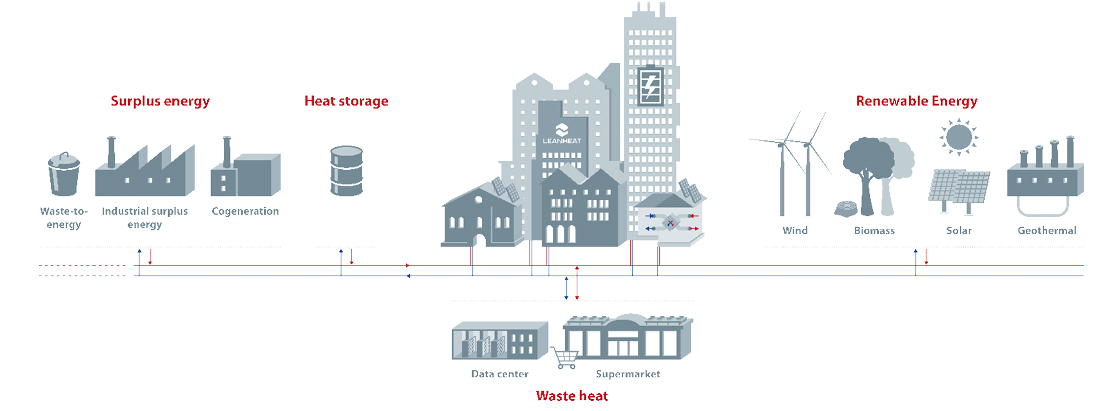District Heating
District heating is a system that distributes heat from a central source to multiple buildings, significantly reducing greenhouse gas emissions by eliminating the need for individual heating systems in each building.

Image credit: Dan Foss
View open jobs in this Solution
Example Companies
- Aalborg Energie Technik - Specializes in biomass-fired district heating plants.
- Danfoss - Provides solutions for energy-efficient district heating systems.
- Fortum - Develops and operates district heating networks in multiple countries.
- Siemens - Offers technologies for efficient district heating and cooling.
- Eloq - Focuses on innovative solutions for district heating and energy efficiency.
Overview
District heating is a system that distributes heat from a central source to multiple buildings. By eliminating the need for individual heating systems in each building, it has the potential to significantly reduce greenhouse gas emissions. Enhanced by technologies like "enhanced geothermal systems" (EGS), which inject water into hot rock formations for efficient heat capture, district heating offers promise for large-scale power generation.
Progress Made
Significant progress has been made in district heating technologies and practices:
- Centrally Produced Heat: Heat is produced centrally and distributed via insulated pipes.
- Technological Advancements: Recent advancements enhance efficiency and reduce emissions.
- High-Temperature Systems: Systems with temperatures up to 140°C boost efficiency and reduce emissions.
Solutions by Sector
Urban District Heating
- Centralized Heat Production: Large-scale heat production facilities serving urban areas.
- Insulated Pipe Networks: Efficient distribution of heat through insulated pipes.
- Heat Recovery: Utilizing waste heat from industrial processes for district heating.
Case Studies:
- Copenhagen District Heating, Denmark: One of the world's largest district heating networks, serving 98% of the city's buildings (Copenhagen Energy).
- Helsinki District Heating, Finland: Integrates waste heat recovery and renewable energy sources (Helen).
- Paris Urban Heating Company, France: Uses geothermal energy and biomass to supply heat to the city (CPCU).
Industrial Applications
- Industrial Heat Recovery: Capturing waste heat from industrial processes for district heating.
- Combined Heat and Power (CHP): Generating electricity and useful heat simultaneously.
- Biomass-Fired Plants: Using biomass as a renewable fuel source for district heating.
Case Studies:
- Aalborg Energie Technik, Denmark: Specializes in biomass-fired district heating plants (Aalborg Energie Technik).
- Fortum, Sweden: Operates CHP plants that provide electricity and district heating (Fortum).
- Siemens, Germany: Implements CHP solutions for industrial and urban applications (Siemens).
Residential and Community Heating
- Geothermal District Heating: Using geothermal energy for residential district heating systems.
- Solar Thermal Integration: Combining solar thermal energy with district heating.
- Community Heat Networks: Small-scale district heating systems for residential communities.
Case Studies:
- Reykjavik Geothermal District Heating, Iceland: Utilizes geothermal energy to provide heat to the city (Orkuveita Reykjavíkur).
- Danfoss, Denmark: Provides solutions for energy-efficient residential district heating systems (Danfoss).
- Eloq, Sweden: Focuses on innovative solutions for community district heating (Eloq).
Lessons Learned
- Careful Planning and Execution: Due to system complexity, careful planning and execution are vital.
- Reliable Heat Source: Ensuring a constant and reliable heat source is challenging.
- Coordination Among Stakeholders: Overcoming challenges requires coordination among utility companies, government agencies, and private developers.
- Infrastructure Development: Developing and maintaining robust pipe networks is essential.
Challenges Ahead
- High Upfront Cost: Significant investment required for district heating infrastructure.
- Reliable Heat Source: Ensuring constant heat availability is crucial.
- Robust Infrastructure: Developing and maintaining extensive pipe networks.
- Public Awareness: Increasing awareness about the benefits of district heating.
Best Path Forward
- Raise Awareness: Educate the public about the benefits of district heating.
- Government and Industry Support: Foster development and implementation through support.
- Robust Regulatory Framework: Encourage adoption through supportive regulations.
- Efficiency in Design and Operation: Ensure optimal system functioning through efficient design and operation.
Promising Outlook
District heating, with proper policies, could fulfill up to one-third of the world's heating needs by 2050, according to the International Energy Agency (IEA). Awareness raising, support from government and industry leaders, robust regulations, and efficient system operation are essential steps in making district heating a significant contributor to climate change mitigation.
Image credit: Dan Foss